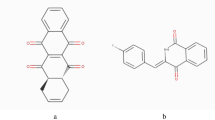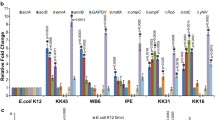Abstract
Colibactin and cytotoxic necrotizing factor 1 (Cnf 1) are cyclomodulins secreted by uropathogenic E. coli. In this study, uropathogenic E. coli expressing colibactin and Cnf 1 was exposed to antibiotics subMICs and gamma radiation to investigate their effects on its cytotoxicity and expression of colibactin. The test isolate was exposed to three subMIC levels of levofloxacin, ciprofloxacin, trimethoprim/sulfamethoxazole and ceftriaxone and irradiated with gamma rays at 10 and 24.4 Gy. The cytotoxicity for either antibiotic or gamma rays treated cultures was measured using MTT assay and the expression of colibactin encoding genes was determined by RT-PCR. Treatment with fluoroquinolones nearly abolished the cytotoxicity of E. coli isolate and significantly downregulated clbA gene expression at the tested subMICs (P ≤ 0.05) while trimethoprim/sulfamethoxazole treated cultures exerted significant downregulation of clbA and clbQ genes at 0.5 MIC only (P ≤ 0.05). Ceftriaxone treated cultured exhibited reduction in the cytotoxicity and insignificant effects on expression of clbA, clbQ and clbM genes. On contrast, significant upregulation in the expression of clbA and clbQ genes was observed in irradiated cultures (P ≤ 0.05). Fluoroquinolones reduced both the cytotoxicity of UPEC isolate and colibactin expression at different subMICs while ceftriaxone at subMICs failed to suppress the expression of genotoxin, colibactin, giving an insight to the risks associated upon their choice for UTI treatment. Colibactin expression was enhanced by gamma irradiation at doses resembling these received during pelvic radiotherapy which might contribute to post-radiotherapy complications.




Similar content being viewed by others
References
Dubois D, Delmas J, Cady A, Robin F, Sivignon A, Oswald E, Bonnet R (2010) Cyclomodulins in urosepsis strains of Escherichia coli. J Clin Microbiol 48:2122–2129. https://doi.org/10.1128/JCM.02365-09
Raisch J, Buc E, Bonnet M, Sauvanet P, Vazeille E, De Vallée A, Déchelotte P, Darcha C, Pezet D, Bonnet R (2014) Colon cancer-associated B2 Escherichia coli colonize gut mucosa and promote cell proliferation. World J Gastroenterol 20:6560. https://doi.org/10.3748/wjg.v20.i21.6560
Faïs T, Delmas J, Barnich N, Bonnet R, Dalmasso G (2018) Colibactin: more than a new bacterial toxin. Toxins 10:151. https://doi.org/10.3390/toxins10040151
Fabbri A, Travaglione S, Ballan G, Loizzo S, Fiorentini C (2013) The cytotoxic necrotizing factor 1 from E. coli: a janus toxin playing with cancer regulators. Toxins 5:1462–1474. https://doi.org/10.3390/toxins5081462
Nougayrède J, Homburg S, Taieb F, Boury M, Brzuszkiewicz E, Gottschalk G, Buchrieser C, Hacker J, Dobrindt U, Oswald E (2006) Escherichia coli induces DNA double-strand breaks in eukaryotic cells. Science 313:848–851. https://doi.org/10.1126/science.1127059
Feng Y, Mannion A, Madden C, Swennes A, Townes C, Byrd C, Marini R, Fox J (2017) Cytotoxic Escherichia coli strains encoding colibactin and cytotoxic necrotizing factor (CNF) colonize laboratory macaques. Gut Pathog 9:71. https://doi.org/10.1186/s13099-017-0220-y
Lax AJ (2007) New genotoxin shows diversity of bacterial attack mechanisms. Trends Mol Med 13:91–93. https://doi.org/10.1016/j.molmed.2007.01.001
Lu M, Chen Y, Chiang M, Wang Y, Hsiao P, Huang Y, Lin C, Cheng C, Liang C, Lai Y (2017) Colibactin contributes to the hypervirulence of pks+ K1 CC23 Klebsiella pneumoniae in mouse meningitis infections. Front Cell Infect Microbiol 7:103. https://doi.org/10.3389/fcimb.2017.00103
Garcia A, Mannion A, Feng Y, Madden C, Bakthavatchalu V, Shen Z, Ge Z, Fox J (2016) Cytotoxic Escherichia coli strains encoding colibactin colonize laboratory mice. Microbes Infect 18:777–786. https://doi.org/10.1016/j.micinf.2016.07.005
Cougnoux A, Dalmasso G, Martinez R, Buc E, Delmas J, Gibold L, Sauvanet P, Darcha C, Dechelotte P, Bonnet M, Pezet D, Wodrich H, Darfeuille-Michaud A, Bonnet R (2014) Bacterial genotoxin colibactin promotes colon tumour growth by inducing a senescence-associated secretory phenotype. Gut 63:1932–1942. https://doi.org/10.1136/gutjnl-2013-305257
Morgan R, Saleh S, Farrag H, Aboulwafa M (2019) Prevalence and pathologic effects of colibactin and cytotoxic necrotizing factor-1 (Cnf 1) in Escherichia coli: experimental and bioinformatics analyses. Gut Pathog 11:22. https://doi.org/10.1186/s13099-019-0304-y
Huang E, Stafford R (2002) National patterns in the treatment of urinary tract infections in women by ambulatory care physicians. Arch Intern Med 162(1):41–47. https://doi.org/10.1001/archinte.162.1.41
Kallen A, Welch H, Sirovich B (2006) Current antibiotic therapy for isolated urinary tract infections in women. Arch Intern Med 166(6):635–639. https://doi.org/10.1001/archinte.166.6.635
Stahlmann R (2003) Children as a special population at risk–quinolones as an example for xenobiotics exhibiting skeletal toxicity. Arch Toxicol 77(1):7–11. https://doi.org/10.1007/s00204-002-0412-0
Paintsil E (2013) Update on recent guidelines for the management of urinary tract infections in children: the shifting paradigm. Curr Opin Pediatr 25(1):88–94. https://doi.org/10.1097/mop.0b013e32835c14cc
Guneysel O, Onur O, Erdede M, Denizbasi A (2009) Trimethoprim/sulfamethoxazole resistance in urinary tract infections. J Emerg Med 36(4):338–341. https://doi.org/10.1016/j.jemermed.2007.08.068
Bergeron M (1995) Treatment of pyelonephritis in adults. Med Clin N Am 79(3):619–649. https://doi.org/10.1016/S0025-7125(16)30060-8
Braga P, Sala M, dal Sasso M (1999) Pharmacodynamic effects of subinhibitory concentrations of rufloxacin on bacterial virulence factors. Antimicrob Agents Chemother 43:1013–1019. https://doi.org/10.1128/AAC.43.5.1013
Turnidge J (1999) Pharmacokinetics and pharmacodynamics of fluoroquinolones. Drugs 58:29–36. https://doi.org/10.2165/00003495-199958002-00006
Preston S, Drusano G, Berman A, Fowler C, Chow A, Dornseif B, Reichl V, Natarajan J, Corrado M (1998) Pharmacodynamics of levofloxacin: a new paradigm for early clinical trials. JAMA 279:125–129. https://doi.org/10.1001/jama.279.2.125
Mandell L, Afnan M (1991) Mechanisms of interaction among subinhibitory concentrations of antibiotics, human polymorphonuclear neutrophils, and gram-negative bacilli. Antimicrob Agents Chemother 35:1291–1307. https://doi.org/10.1128/AAC.35.7.1291
Baskin H, Doğan Y, Bahar IH, Yuluğ N (2002) Effect of subminimal inhibitory concentrations of three fluoroquinolones on adherence of uropathogenic strains of Escherichia coli. Int J Antimicrob Agents 19:79–82. https://doi.org/10.1016/S0924-8579(01)00469-1
Yuk J, Nightingale C, Quintiliani R (1989) Clinical pharmacokinetics of ceftriaxone. Clin Pharmacokinet 17:223–235. https://doi.org/10.2165/00003088-198917040-00002
Nassar F, Rahal E, Sabra A, Matar G (2013) Effects of subinhibitory concentrations of antimicrobial agents on Escherichia coli O157: H7 Shiga toxin release and role of the SOS response. Foodborne Pathog Dis 10:805–812. https://doi.org/10.1089/fpd.2013.1510
Cairns J, Becks L, Jalasvuori M, Hiltunen T (2017) Sublethal streptomycin concentrations and lytic bacteriophage together promote resistance evolution. Philos Trans R Soc Lond B Biol Sci 372:20160040. https://doi.org/10.1098/rstb.2016.0040
Sud I, Feingold D (1975) Detection of agents that alter the bacterial cell surface. Antimicrob Agents Chemother 8:34–37. https://doi.org/10.1128/AAC.8.1.34
Breines D, Burnham J (1994) Modulation of Escherichia coli type 1 fimbrial expression and adherence to uroepithelial cells following exposure of logarithmic phase cells to quinolones at subinhibitory concentrations. J Antimicrob Chemother 34:205–221. https://doi.org/10.1093/jac/34.2.205
da Silva E, Mansano E, Miazima E, Rodrigues F, Hernandes L, Svidzinski T (2017) Radiation used for head and neck cancer increases virulence in Candida tropicalis isolated from a cancer patient. BMC Infect Dis 17:783. https://doi.org/10.1186/s12879-017-2879-6
Shuford R, Dulaney C, Burnett O III, Byram K, McDonald A (2016) Evaluating the role of urinalysis for suspected cystitis in women undergoing pelvic radiotherapy. Int J Gynecol Cancer. https://doi.org/10.1097/IGC.0000000000000714
van Vliet M, Harmsen H, de Bont E, Tissing W (2010) The role of intestinal microbiota in the development and severity of chemotherapy-induced mucositis. PLoS Pathog 6:e1000879. https://doi.org/10.1371/journal.ppat.1000879
Webb G, Brooke R, De Silva A (2013) Chronic radiation enteritis and malnutrition. J Dig Dis 14:350–357. https://doi.org/10.1111/1751-2980.12061
Prasad K, Pradhan S, Datta N (1995) Urinary tract infection in patients of gynecological malignancies undergoing external pelvic radiotherapy. Gynecol Oncol 57:380–382. https://doi.org/10.1006/gyno.1995.1158
Packey C, Ciorba M (2010) Microbial influences on the small intestinal response to radiation injury. Curr Opin Gastroenterol 26:88. https://doi.org/10.1097/mog.0b013e3283361927
Wiegand I, Hilpert K, Hancock R (2008) Agar and broth dilution methods to determine the minimal inhibitory concentration (MIC) of antimicrobial substances. Nat Protoc 3:163. https://doi.org/10.1038/nprot.2007.521
Atsumi T, Fujimoto E, Furuta M, Kato M (2014) Effect of gamma-ray irradiation on Escherichia coli motility. Cent Eur J Biol 9:909–914. https://doi.org/10.2478/s11535-014-0332-z
Edmondson J, Armstrong L, Martinez A (1988) A rapid and simple MTT-based spectrophotometric assay for determining drug sensitivity in monolayer cultures. J Tissue Cult Methods 11:15–17
Homburg S, Oswald E, Hacker J, Dobrindt U (2007) Expression analysis of the colibactin gene cluster coding for a novel polyketide in Escherichia coli. FEMS Microbiol Lett 275:255–262. https://doi.org/10.1111/j.1574-6968.2007.00889.x
Livak K, Schmittgen T (2001) Analysis of relative gene expression data using real-time quantitative PCR and the 2− ΔΔCT method. Methods 25:402–408. https://doi.org/10.1006/meth.2001.1262
Martin P, Marcq I, Magistro G, Penary M, Garcie C, Payros D, Boury M, Olier M, Nougayrède J, Audebert M (2013) Interplay between siderophores and colibactin genotoxin biosynthetic pathways in Escherichia coli. PLoS Pathog 9:e1003437. https://doi.org/10.1371/journal.ppat.1003437
Sonstein S, Burnham J (1993) Effect of low concentrations of quinolone antibiotics on bacterial virulence mechanisms. Diagn Microbiol Infect Dis 16:277–289. https://doi.org/10.1016/0732-8893(93)90078-L
Soto S, De Anta M, Vila J (2006) Quinolones induce partial or total loss of pathogenicity islands in uropathogenic Escherichia coli by SOS-dependent or-independent pathways, respectively. Antimicrob Agents Chemother 50:649–653. https://doi.org/10.1128/AAC.50.2.649-653.2006
Smith A, Pennefather P, Kaye S, Hart C (2001) Fluoroquinolones: place in ocular therapy. Drugs 61(6):747–761. https://doi.org/10.2165/00003495-200161060-00004
Wright S, Wrenn K, Haynes M (1999) Trimethoprim-sulfamethoxazole resistance among urinary coliform isolates. J Gen Intern Med 14(10):606–609
Taieb F, Petit C, Nougayrède J, Oswald E (2016) The enterobacterial genotoxins: cytolethal distending toxin and colibactin. EcoSal Plus. https://doi.org/10.1128/ecosalplus.esp-0008-2016
Mousa J, Yang Y, Tomkovich S, Shima A, Newsome R, Tripathi P, Oswald E, Bruner S, Jobin C (2016) MATE transport of the E. coli-derived genotoxin colibactin. Nat Microbiol 1:15009. https://doi.org/10.1038/nmicrobiol.2015.9
Kuroda T, Tsuchiya T (2009) Multidrug efflux transporters in the MATE family. Biochim Biophys Acta 1794:763–768. https://doi.org/10.1016/j.bbapap.2008.11.012
Guntaka N, Healy A, Crawford J, Herzon S, Bruner S (2017) Structure and functional analysis of ClbQ, an unusual intermediate-releasing thioesterase from the colibactin biosynthetic pathway. ACS Chem Biol 12:2598–2608. https://doi.org/10.1021/acschembio.7b00479
Piatti G, Mannini A, Balistreri M, Schito A (2008) Virulence factors in urinary Escherichia coli strains: phylogenetic background and quinolone and fluoroquinolone resistance. J Clin Microbiol 46:480–487. https://doi.org/10.1128/JCM.01488-07
Thi T, López E, Rodríguez-Rojas A, Rodríguez-Beltrán J, Couce A, Guelfo J, Castañeda-García A, Blázquez J (2011) Effect of recA inactivation on mutagenesis of Escherichia coli exposed to sublethal concentrations of antimicrobials. J Antimicrob Chemother 66:531–538. https://doi.org/10.1093/jac/dkq496
Barriere S, Flaherty J (1984) Third-generation cephalosporins: a critical evaluation. J Clin Pharm Ther 3:351–373
Booth C, Siemens D, Li G, Peng Y, Kong W, Berman D, Mackillop W (2014) Curative therapy for bladder cancer in routine clinical practice: a population-based outcomes study. Clin Oncol 26:506–514. https://doi.org/10.1016/j.clon.2014.05.007
Zilli T, Scorsetti M, Zwahlen D, Franzese C, Förster R, Giaj-Levra N, Koustouvelis N, Bertaut A, Zimmermann M, D’Agostino G (2018) ONE SHOT-single shot radiotherapy for localized prostate cancer: study protocol of a single arm, multicenter phase I/II trial. Radiat Oncol 13:166. https://doi.org/10.1186/s13014-018-1112-0
Min J, Lee C, Gu M (2003) Gamma-radiation dose-rate effects on DNA damage and toxicity in bacterial cells. Radiat Environ Biophys 42:189–192. https://doi.org/10.1007/s00411-003-0205-8
Li B, Smith P, Horvath D Jr, Romesberg F, Justice S (2010) SOS regulatory elements are essential for UPEC pathogenesis. Microbes infect 12:662–668. https://doi.org/10.1016/j.micinf.2010.04.009
Min J, Lee CW, Moon SH, LaRossa RA, Gu MB (2000) Detection of radiation effects using recombinant bioluminescent Escherichia coli strains. Radiat Environ Biophys 39(1):41–45. https://doi.org/10.1007/pl00007683
Funding
This research did not receive any grants from funding agencies in the public, commercial, or not-for-profit sectors.
Author information
Authors and Affiliations
Contributions
All authors contributed in the study conception and design equally. RM, conducted the practical work and collected the results, SS, supervised the practical work, HF, revised the first draft of the manuscript and MA revised the final version of the manuscript and produced in its final form. All authors have read and approved the final form of the manuscript. All Authors follow the ICMJE criteria.
Corresponding author
Ethics declarations
Conflict of interest
The authors declare that they have no conflict of interest.
Additional information
Publisher's Note
Springer Nature remains neutral with regard to jurisdictional claims in published maps and institutional affiliations.
Rights and permissions
About this article
Cite this article
Morgan, R.N., Farrag, H.A., Aboulwafa, M.M. et al. “Effect of Subinhibitory Concentrations of Some Antibiotics and Low Doses of Gamma Radiation on the Cytotoxicity and Expression of Colibactin by an Uropathogenic Escherichia coli isolate”. Curr Microbiol 78, 544–557 (2021). https://doi.org/10.1007/s00284-020-02331-6
Received:
Accepted:
Published:
Issue Date:
DOI: https://doi.org/10.1007/s00284-020-02331-6




